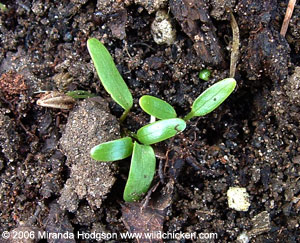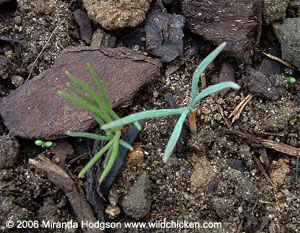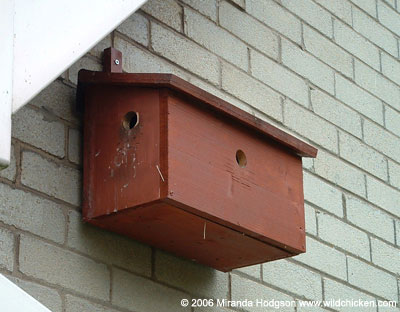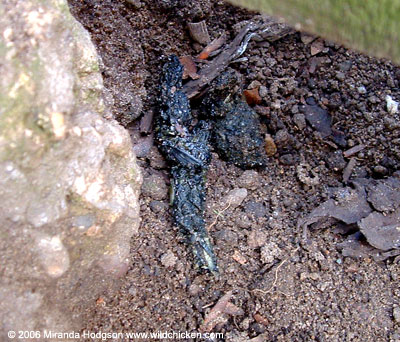18th April 2006 - Burgeoning - and fighting - wildlife
Ten days on and spring is finally getting started. What a difference a few days of sunshine can make. The woodland floor, which is becoming greener every day, is now speckled with the white of the wind flower, Anemone nemorosa and under the hedgerows there are patches of yellow as the celandines open. Fat buds are getting ready to open on the rowan in the front garden and the soil is becoming populated with tiny sprouts of seedlings. I know what some of them will be – Eschscholzia is obvious with its narrow blue-green leaves, as is Astrantia major, which has two glossy, rounded oblong seed leaves - but others will remain a mystery for the next week or so.
"The woodland floor, which is becoming greener every day, is now speckled with the white of the wind flower, Anemone nemorosa"

Astrantia seedlings

Eschscholzia seedlings
Looking back at photos from April 2005, I reckon that the garden is a month behind what it was doing this time last year. Dicentra spectabilis is just coming into bud, whereas on the 4th of April 2005 it was already flowering. The same growth rate can be seen with ferns, cowslips, king cups in the pond (Caltha palustris) and the Pasque flower (Pulsatilla vulgaris) – all of them, and more, are a month behind compared to last year.
The laggardliness of the spring has given me extra time to divide some of the perennials before they really get going – Heuchera sanguinea ‘Geisha’s Fan’ and H. ‘Plum Pudding’, Sedum spectabile, Japanese anemones (Anemone x hybrida 'Honorine Jobert'), Eryngiums (‘Silver Ghost’), Potentillas and Geranium phaeum. Looking forward to that bit more colour this year, all being well.
We’ve finally given the lawn its first cut (14th of April), having bought a new mower. It’s electric again as the petrol ones, whilst they look great, are too big to fit into our shed. Electric ones are cheaper too. This one is a Bosch and it’s got a wider blade and wheelbase than the last one, and a bigger collecting box. Works fine, though I still get tangled in the cable.
The frog spawn has hatched, 12 days later than last year, and the young tadpoles are exploring the pond. They’re tiny, no more than 1cm long, and there seem to be thousands of them. The frogs themselves have left the pond for the moment; we haven’t seen them for a while, anyway.
A few things have happened since last time. The blackbirds have hatched their eggs, three of them, and are busy gathering up the meal worms we put out in little dishes. There aren’t many caterpillars and bugs for the young birds yet, so we thought the parents would like some meal worms handy to help feed their hatchlings.
The availability of such fine food has caused conflict, though. A female blackbird from next door’s garden is currently waging war with the female from our garden. Both seem to think that the back of our garden is their own territory and are defending it vigorously. It’s frustrating to see them spending their time chasing one another about rather than feeding their young; it's just as well that the males are involved in caring for the hatchlings.
Yesterday I found myself in the slightly surreal position of breaking up a fight between these warring birds. I’d been watching them out of the kitchen window and saw them change from the usual monotonous chasing and clucking to suddenly attacking each other, flapping their wings and pecking. After flailing at each other for a few moments, they tumbled off the woodpile and fell amongst a pile of apple prunings next to it, ending up right at the bottom.
Concerned that they might have got themselves tangled amongst the twigs, I went out to see what was going on. Following the rustlings and squeaks of pain, I discovered them on the ground behind the wood pile, fighting fiercely, pecking and scratching at each other, beaks and claws going furiously as they rolled about with their wings flapping. It looked brutal and I feared they might really hurt each other. I shouted at them to ‘Stop it immediately!’ and loudly clapped my hands. No response, so I picked up a stick from the pile of prunings and waved it at them, shouting again. Still no response, so I reached out and gently prodded at them with the stick, at which they suddenly became aware of me and separated, each going off, shrieking, in different directions.
Feeling a bit trembly, I came back into the house and stood looking out of the kitchen window for a couple of minutes, thinking about what an odd experience that was, breaking up a bird fight. ‘Our’ female returned after a couple of minutes, looking flustered, with a few feathers askew. She had a drink and bathed herself before eating a little, something you could imagine a human doing in a similar situation, and I felt a certain sympathy for her.
It’s difficult to know what to do when birds fight that way. Leave them to it and they may kill each other. We know of a bird that died of its injuries last year. A female blackbird it was, who had had her beak broken; it was hanging open so that she could neither eat nor drink and was a horrible and distressing sight; far worse for her, of course. We tried to catch her for two days, hoping to end her misery, but she always got away and we kept catching sight of her as she weakened, feebly trying to peck at apples or dipping her broken beak into the water dish, all to no avail. She always found the energy to flap away from us onto a roof if we approached and we couldn’t help, only watch. A few days later she disappeared. The thought of seeing a bird in that state again was what prompted me to act yesterday and break this fight up.
In the end, they have to sort it out between themselves, as the fight is doubtless over territory as well as food. The young blackbirds in our garden are eight days old now, and will leave the nest at around 14 days; we hope they’ll get through the time without their mothers killing each other.
On to more cheerful matters, almost two weeks to the day after putting the robin box back up and replacing the eggs, they’re hatching. A quick glimpse into the box shows that at least two have hatched and the birds are obviously busy gathering food for the young ones. I could just see an egg in there along with two grey-pink blobby-looking babies, but didn’t want to linger longer than necessary, so didn’t see if there were other eggs or babies. The next few days will tell.
Yet more bird business is going on at the side of the house, where the sparrows are using their des res again. This was the box that Karl made for them last year, which they used within days of it being put up. As ever, they started ripping the Stipa tenuissima to bits - it seems to be a current favourite for nesting material. I was ready for them this time, having saved a pile of it from last year, which I put out for them. As planned, they’re going through it and carrying away large amounts, leaving my grasses to grow.

The sparrow terrace that Karl made
A couple of years ago, Karl and I were trying to figure out how to encourage next door’s toads into our garden. About half of the boundary is walled, but there are two sections of fencing between us and both neighbours. We were thinking that, if the toads wanted to, it would nice if they spent some time in our garden eating slugs. To help them find their way, we scraped out a couple of underpasses beneath the fence. Nothing happened for a long time, but last weekend I noticed that both routes are being used and have even been enlarged. There are definite scratch marks and tracks and, the most telling evidence, droppings.

Hedgehog droppings
A search online leads me to believe that at least one hedgehog is using the underpass. Just to make sure, I also checked on rat droppings and found that the two are quite different. The stuff that rats leave behind looks like brown jelly beans, whereas hedgehog droppings are black, long and crinkly, like the ones we saw. Hedgehogs are as good as toads, probably better, for keeping the slug population down, so we’re well pleased with that result.
I know this entry has got rather long, but there’s one more thing. As I was getting ready for bed last night, I started to count up the birds and beasts I know of who would be sleeping nearby, in trees, shrubs, holes and ponds. Curled into their fur, heads under wings, nestling into feathers, unstirring amongst the pond weeds. Call me soft, but the thought of them sleeping all around us brought a warmth to my heart and made me smile.
© Copyright Miranda Hodgson 2006